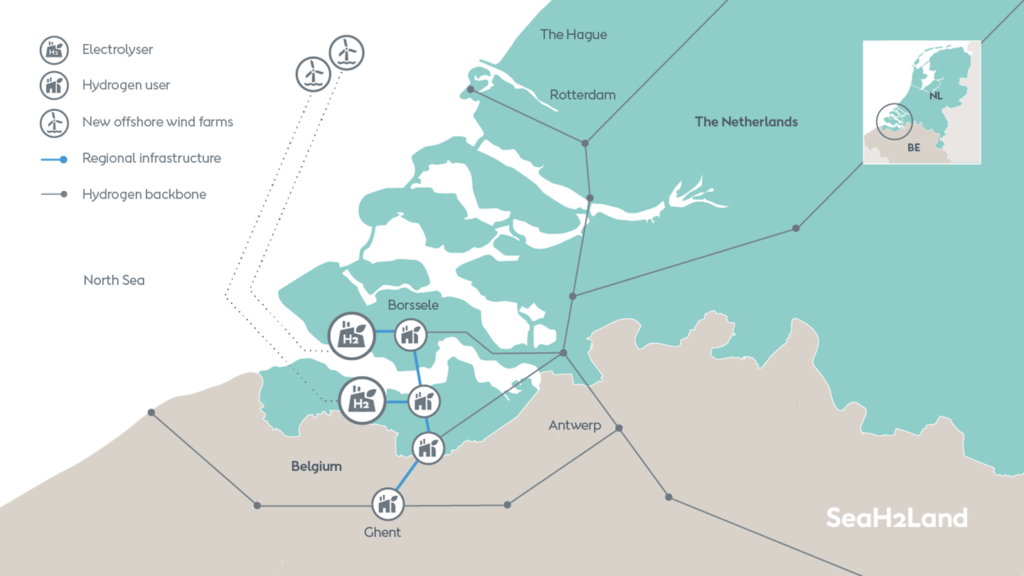Ørsted to Develop One of the World’s Largest Renewable Hydrogen Plants in the Netherlands
SeaH2Land would meet the large industrial demand in the Dutch-Flemish North Sea Port cluster

Photo: Ørsted
Denmark-based Ørsted, the world leader in offshore wind energy, has ambitions to develop the world’s largest renewable hydrogen plant in the Netherlands. The ‘SeaH2Land’ project aims to link GW-scale electrolysis to the large industrial demand in the Dutch-Flemish North Sea Port cluster through a cross-border pipeline.
The green electricity required to produce the renewable hydrogen is proposed to come from the build-out of additional large-scale offshore wind. The major industrial companies in the region – ArcelorMittal, Yara, Dow Benelux and Zeeland Refinery – support the development of the required regional infrastructure. This will enable sustainably-produced steel, ammonia, ethylene, and fuels in the future, helping Belgium and the Netherlands to accelerate their carbon reductions towards 2030 and beyond.
The industrial players have united in the Smart Delta Resources (SDR) partnership to liaise with regional regulatory authorities about developing a regional open-access pipeline network of about 45 km, stretching across the North Sea Port area from Vlissingen, the Netherlands, to Gent, Belgium.
Transition to sustainable energy
The SeaH2Land vision includes a renewable hydrogen production facility of 1 GW by 2030 to be developed by Ørsted. If realized, the electrolyser, which will produce the renewable hydrogen, can convert about 20% of the current hydrogen consumption in the region to renewable hydrogen.
With 580,000 tonnes per year, the North Sea Port cluster is one of the largest production and demand centres of fossil hydrogen in Europe today. Driven by decarbonisation efforts in the transition to sustainable energy, industrial demand in the cluster could grow to about 1,000,000 tonnes by 2050, equivalent to roughly 10 GW of electrolysis.
GW electrolyser directly linked to new 2 GW offshore wind farm
Ørsted proposes to connect the GW electrolyser directly to a new 2 GW offshore wind farm in the Dutch North Sea. This will enable the large-scale supply of renewable electricity required for production of renewable hydrogen and fits well with the ambitions of the Dutch authorities for an accelerated offshore wind development.
Renewable hydrogen can contribute to a green economy in Europe
Daan Schalck, CEO, North Sea Port, said: ‘North Sea Port welcomes the ambition of Ørsted to further develop the cross-border port as an important hydrogen cluster in Europe together with the big industrial companies in the region.’
Martin Neubert, Chief Commercial Officer and Deputy Group CEO, Ørsted, said: ‘The Dutch-Flemish North Sea Port covers one of the largest hydrogen clusters in Europe. As the world looks to decarbonize, it’s paramount that we act now to secure the long-term competitiveness of European industry in a green economy. The SeaH2Land project outlines a clear vision and roadmap for large-scale renewable hydrogen linked to new offshore wind capacity. With the right framework in place, the Netherlands and Belgium can leverage the nearly unlimited power of offshore wind to significantly advance renewable hydrogen as a true European industrial success story.’
Steven Engels, General Manager Benelux, Ørsted, stated: ‘SeaH2Land will help the Netherlands to accelerate its offshore wind build-out and to work towards its ambition of 3-4 GW electrolyser capacity by 2030. SeaH2Land offers the Netherlands and Belgium an opportunity to get closer to realising its 2030 climate goals by reducing carbon emissions in the industrial sector.’
Source: Orsted press release
9 April 2021